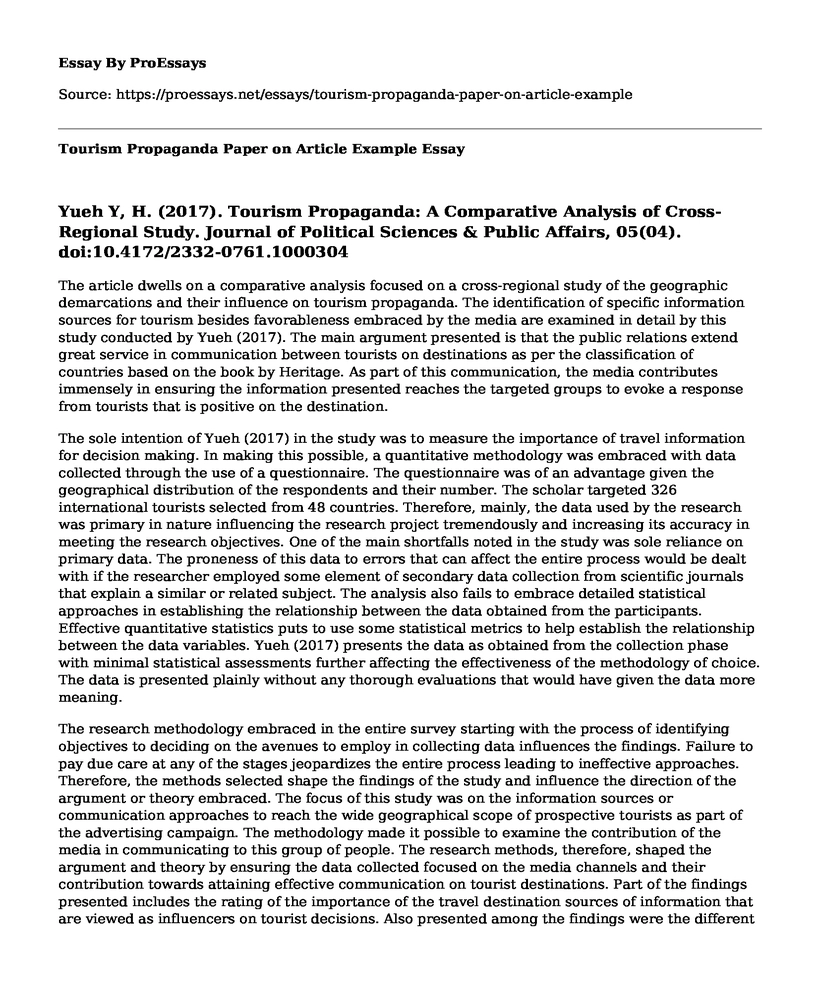Yueh Y, H. (2017). Tourism Propaganda: A Comparative Analysis of Cross-Regional Study. Journal of Political Sciences & Public Affairs, 05(04). doi:10.4172/2332-0761.1000304
The article dwells on a comparative analysis focused on a cross-regional study of the geographic demarcations and their influence on tourism propaganda. The identification of specific information sources for tourism besides favorableness embraced by the media are examined in detail by this study conducted by Yueh (2017). The main argument presented is that the public relations extend great service in communication between tourists on destinations as per the classification of countries based on the book by Heritage. As part of this communication, the media contributes immensely in ensuring the information presented reaches the targeted groups to evoke a response from tourists that is positive on the destination.
The sole intention of Yueh (2017) in the study was to measure the importance of travel information for decision making. In making this possible, a quantitative methodology was embraced with data collected through the use of a questionnaire. The questionnaire was of an advantage given the geographical distribution of the respondents and their number. The scholar targeted 326 international tourists selected from 48 countries. Therefore, mainly, the data used by the research was primary in nature influencing the research project tremendously and increasing its accuracy in meeting the research objectives. One of the main shortfalls noted in the study was sole reliance on primary data. The proneness of this data to errors that can affect the entire process would be dealt with if the researcher employed some element of secondary data collection from scientific journals that explain a similar or related subject. The analysis also fails to embrace detailed statistical approaches in establishing the relationship between the data obtained from the participants. Effective quantitative statistics puts to use some statistical metrics to help establish the relationship between the data variables. Yueh (2017) presents the data as obtained from the collection phase with minimal statistical assessments further affecting the effectiveness of the methodology of choice. The data is presented plainly without any thorough evaluations that would have given the data more meaning.
The research methodology embraced in the entire survey starting with the process of identifying objectives to deciding on the avenues to employ in collecting data influences the findings. Failure to pay due care at any of the stages jeopardizes the entire process leading to ineffective approaches. Therefore, the methods selected shape the findings of the study and influence the direction of the argument or theory embraced. The focus of this study was on the information sources or communication approaches to reach the wide geographical scope of prospective tourists as part of the advertising campaign. The methodology made it possible to examine the contribution of the media in communicating to this group of people. The research methods, therefore, shaped the argument and theory by ensuring the data collected focused on the media channels and their contribution towards attaining effective communication on tourist destinations. Part of the findings presented includes the rating of the importance of the travel destination sources of information that are viewed as influencers on tourist decisions. Also presented among the findings were the different platforms for promotions listed on the basis of the cross-sectional ranking in which social media or networking sites, friends or relatives, websites, guidebooks, brochure, maps and travel guides among others were identified as platforms for promotion. Furthermore, media consumption was also studied in a bid to identify the possible contribution it would make on passing information on the same. Of these, newsletters were the most accessed with a 63% daily consumption followed by regional papers with 13%, BBC/ABC at 12% with the least consumed daily being newspapers or magazines at 6%. Attaining the above was only possible through the methodology selected to drive the study.
The major problem with the above study is on the choice of methodology and associated approaches as earlier detailed. A combination of both secondary and primary data would have enhanced the study findings and added weight on reliability. The study is deprived of detailed statistical assessments with the only measure employed being ANOVA to detailing the importance of travel information. Focusing on the development of research hypotheses or questions that guide the entire research process would have prompted the use of detailed statistical measures to test the hypotheses as a step towards first understanding the relationship between the variables. The absence of scientific sources backing up the assertions made by the researcher also presents a shortfall in this research work. The occurrence of each of these contributes to the deprivation of the reliability of the study with a possible repeat of the same using the similar data but different metrics or statistical measures yielding different results. The questionnaire approach is appropriate for the study and fits well with a quantitative approach to research but is only effective is the data obtained is treated adequately to statistical analysis to identify any gaps or deficiencies that would affect the results. The data obtained through questionnaire would have also been enhanced in the presentation if some graphical representations would have been employed in summarising the findings.
References
Yueh Y, H. (2017). Tourism Propaganda: A Comparative Analysis of Cross-Regional Study. Journal of Political Sciences & Public Affairs, 05(04). doi:10.4172/2332-0761.1000304
Cite this page
Tourism Propaganda Paper on Article Example. (2022, May 26). Retrieved from https://proessays.net/essays/tourism-propaganda-paper-on-article-example
If you are the original author of this essay and no longer wish to have it published on the ProEssays website, please click below to request its removal:
- The Age of Augustus: Essay Sample
- Gilligan vs. Douglass: Examining Discrimination and its Remedies
- O'Keeffe's Success: Breaking Barriers in a Male-Dominated Field - Essay Sample
- Movie Watching: Theatre vs Home - Essay Sample
- Racism in America: White Supremacy and Boundaries of Identity - Essay Sample
- Paper Example on Does the DARE Program Work? Evidence and Findings
- Healthcare for Undocumented Immigrants- Report Sample







